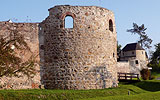Re-shaping the Danube Limes

Re-shaping the Danube Limes
The frontiers of the Roman Empire, from the Danube to the Black Sea, played a crucial role in making and breaking emperors and creating vibrant societies along its course, and a UNESCO World Heritage’ Project is ensuring Rome’s cultural legacy and survival.

The Roman fort of Lussonium/Paks in Hungary will be turned into an archaeological park.
Within the framework of efforts to preserve the archaeological heritage of the Romans in Europe, the frontiers of the Roman Empire, which form the single largest monument to this civilisation, have received a very special role within the context of a newly created transboundary, ‘Frontiers of the Roman Empire World Heritage Site’. This unique site, accepted by the UNESCO Commission in 2005, will now be extended into the Danube countries.
Looking at landscapes long gone. Following the footsteps of the Roman soldiers along the Danube from Bavaria to the Black Sea there is a lot to discover: a frontier system with fortresses and fortlets built by the Roman army preserved in archaeological parks and recreation areas, like Carnuntum (Austria), Aquincum (Budapest, Hungary), Viminacium (near Belgrade, Serbia) or Novae (Svistov, Bulgaria). Together with hundreds of watchtowers and large urban settlements they are part of an impressive archaeological landscape. Yet, far from being at the periphery of the Roman world, this frontier played a crucial role in making and breaking emperors, creating vibrant societies along its course, and ensuring Rome’s cultural legacy and survival.
A string of archaeological pearls. The river itself was the most dominant element of the frontier system, used as a demarcation line against the Barbarian world to the north and as a fortified transport corridor.
The forts, situated mostly on the right side of the river, acted as check-points to control traffic in and out of the empire. Their ruins, above and below ground, visible or non-visible, are often in remarkable shape, well integrated in the landscape and certainly deserve more generous attention. “The frontier once a great divide, forms a unifying element in today’s world,” says Francesco Bandarin, Director of the World Heritage Centre in Paris.

Roman forts and towers likethis one in Mautern, Austria, survived remarkably well.
Legends tell how the Roman empire guarded and maintained this border line for more than 500 years, from its beginning under Augustus to its decline and fall amidst the barbarian invasions of the 5th and 6th centuries AD. Mark Aurel, one of the greatest Roman emperors and a philosopher on Rome’s throne, wrote his lifetime memories here and died on the Danube shores. Although it is fascinating that so many of the remains have survived from antiquity in the world of today, they are more threatened than ever before by urban and rural development. We need to act together to protect and preserve those landscapes and monuments as a historical witness for future generations.
Proactive archaelogical heritage management. The ‘Danube Limes - UNESCO World Heritage’ Project, co-funded by the Central Europe programme, concentrates on protecting and developing the Danube Limes monuments by nominating them for World Heritage status. The process has started in Slovakia, Hungary and Austria and it is intended to spread to all the Danube countries step by step. The project is supported by all the national governments, and NGOs like the ARGE Donauländer and the International Danube Tourist Commission, who declared ‘The Romans on the Danube’ their theme for the year 2010. Regional politicians, mayors and many experts agree that one of the most important issues for the understanding and long-term protection of the Roman remains is the provision of information about the monument to the public and providing better access to the sites.
For more information, please visit:
www.danube-limes.eu; www.limes-oesterreich.at.





